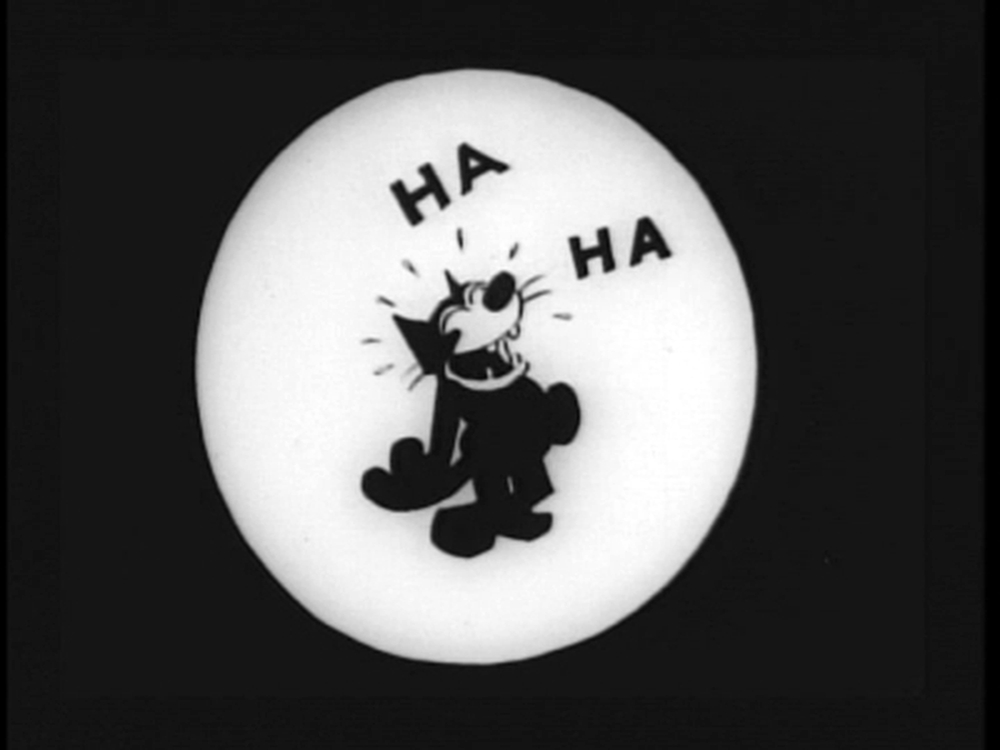Felix the Cat in Hollywood. Felix the Cat. A scene of Felix "laffing" from "Felix in Hollywood" (1923).
This work is in the public domain because it was published in the United States between 1923 and 1963 with a copyright notice, and its copyright was not renewed.
This image may however not be in the public domain in countries that figure copyright from the date of death of the artist (post mortem auctoris) and that most commonly runs for a period of 50 to 70 years from December 31 of that year. This image may not be in the public domain in these countries, which moreover do not implement the rule of the shorter term to US works, If your use will be outside the United States please check your local law.
Image Text: is in the public domain because its copyright has expired. This applies to the United States, where Works published prior to 1978 were copyright protected for a maximum of 75 years. See Circular 1 "COPYRIGHT BASICS" PDF. Works published before 1923, are now in the public domain.
This image text is also in the public domain in countries that figure copyright from the date of death of the artist (post mortem auctoris), in this case Samuel Langhorne Clemens (November 30, 1835 – April 21, 1910), and that most commonly runs for a period of 50 to 70 years from the last day of that year. +sookie tex
Felix the Cat From Wikipedia, the free encyclopedia
Felix the Cat is a cartoon character created in the silent-film era. His black body, white eyes, and giant grin, coupled with the surrealism of the situations in which his cartoons place him, combined to make Felix one of the most recognizable cartoon characters in the world. Felix was the first character from animation to attain a level of popularity sufficient to draw movie audiences based solely on his star power.
Felix's origins remain disputed. Australian cartoonist/film entrepreneur Pat Sullivan, owner of the Felix character, claimed during his lifetime to be its creator as well. American animator Otto Messmer, Sullivan's lead animator, has more commonly been assigned credit in recent decades. Some historians argue that Messmer ghosted for Sullivan. What is certain is that Felix emerged from Sullivan's studio, and cartoons featuring the character enjoyed unprecedented success and popularity in the 1920s.
From 1922, Felix enjoyed sudden, enormous popularity in international popular culture. He got his own comic strip (drawn by Messmer) and his image soon adorned all sorts of merchandise from ceramics to toys to postcards. There were several manufacturers who made stuffed Felix toys. Jazz bands such as Paul Whiteman's played songs about him. The most popular song of 1923 was "Felix Kept On Walking", and further songs followed.
Nevertheless, Felix's success was fading by the late 1920s with the arrival of sound cartoons. These new shorts, particularly those of Walt Disney's Mickey Mouse, had made the silent offerings of Sullivan and Messmer, who were then unwilling to move to sound production, seem outdated. In 1929, Sullivan decided to finally make the transition and began distributing Felix sound cartoons through Copley Pictures. The sound Felix shorts proved to be a failure and the operation ended in 1930 with Sullivan himself passing away in 1933. Felix saw a brief three cartoon resurrection in 1936 by the Van Beuren Studios, but the glory of the old days had disappeared during the cat's short-lived stint in color and sound.
Television would prove the cat's savior. Felix cartoons began airing on American TV in 1953. Meanwhile, Joe Oriolo, who was now directing the Felix comic strips, introduced a redesigned, "long-legged" Felix in a new animated series for TV. Oriolo also added new characters, and gave Felix a "Magic Bag of Tricks", which could assume an infinite variety of shapes at Felix's behest. The cat has since starred in other television programs and in a feature film. Felix is still featured on a wide variety of merchandise from clothing to toys. Oriolo's son, Don Oriolo, now controls creative work on Felix movies.
This article is licensed under the GNU Free Documentation License. It uses material from the Wikipedia article, Felix the Cat SEE FULL License, Credit and Disclaimer
















2 comments:
The history of animation is an interesting topic. It would serve all young animators well to study the pioneers in the industry and learn from them. Felix is still one of my most favorite characters.
ours too rheo :-)
thanks for stopping by
Post a Comment